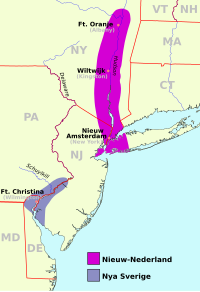Peach Tree War
| Peach Tree War | |||||||||
|---|---|---|---|---|---|---|---|---|---|
| Part of the Second Northern War; American Indian Wars | |||||||||
 An approximation of the borders of New Netherland and New Sweden, c. 1650. |
|||||||||
|
|||||||||
| Belligerents | |||||||||
| Susquehannock and allied tribes | |||||||||
| Commanders and leaders | |||||||||
|
|
|
||||||||
| Strength | |||||||||
| Around 600 | Unknown | ||||||||
| Casualties and losses | |||||||||
| Unknown | Unknown; 150 hostages taken by Native Americans | ||||||||
The Peach Tree War, also known as the Peach War, was a large scale attack by the Susquehannock Nation and allied Native Americans on several New Netherland settlements along the Hudson River (then called the North River), centered on New Amsterdam and Pavonia on September 15, 1655.
The attack was motivated by the Dutch conquest of New Sweden, a close trading partner and protectorate of the Susquehannock. The attack was a decisive victory for the Native Americans, and many outlying Dutch settlements were forced to temporarily garrison in Fort Amsterdam. Some of these settlements, such as the Staten Island colony, were completely abandoned; while others were soon repopulated (and equipped with better defenses), as Director-General Stuyvesant shortly repurchased the rights to settle the west bank of the North River from the Native Americans.
In March 1638, Swedish colonists led by Peter Minuit landed in what is today Wilmington, Delaware, proclaiming the west bank of the Delaware River to be "New Sweden". The area had previously been claimed by both the English and the Dutch but, in part because of their inability to come to terms with the dominant power in the area, the Susquehannock, neither had managed more than marginal occupation. As a dismissed Director of the Dutch West India Company's New Netherland colony, Minuit was familiar with the terrain and local custom and quickly "purchased" the land (really, the right to settle) from the Susquehannock. The Susquehannock were mistrustful of the Dutch due to their close alliance with the Susquehannocks' rivals the Iroquois Confederation. They had lost their English trading partner when the new colony of Maryland had forced out William Claiborne's trading network centered on Kent Island. The Susquehannock quickly became New Sweden's main supplier of furs and pelts and customers for European manufactured goods. In the process, New Sweden became a protectorate and tributory of the Susquehannock nation, which was perhaps the leading power on the Eastern seaboard at the time.
...
Wikipedia
